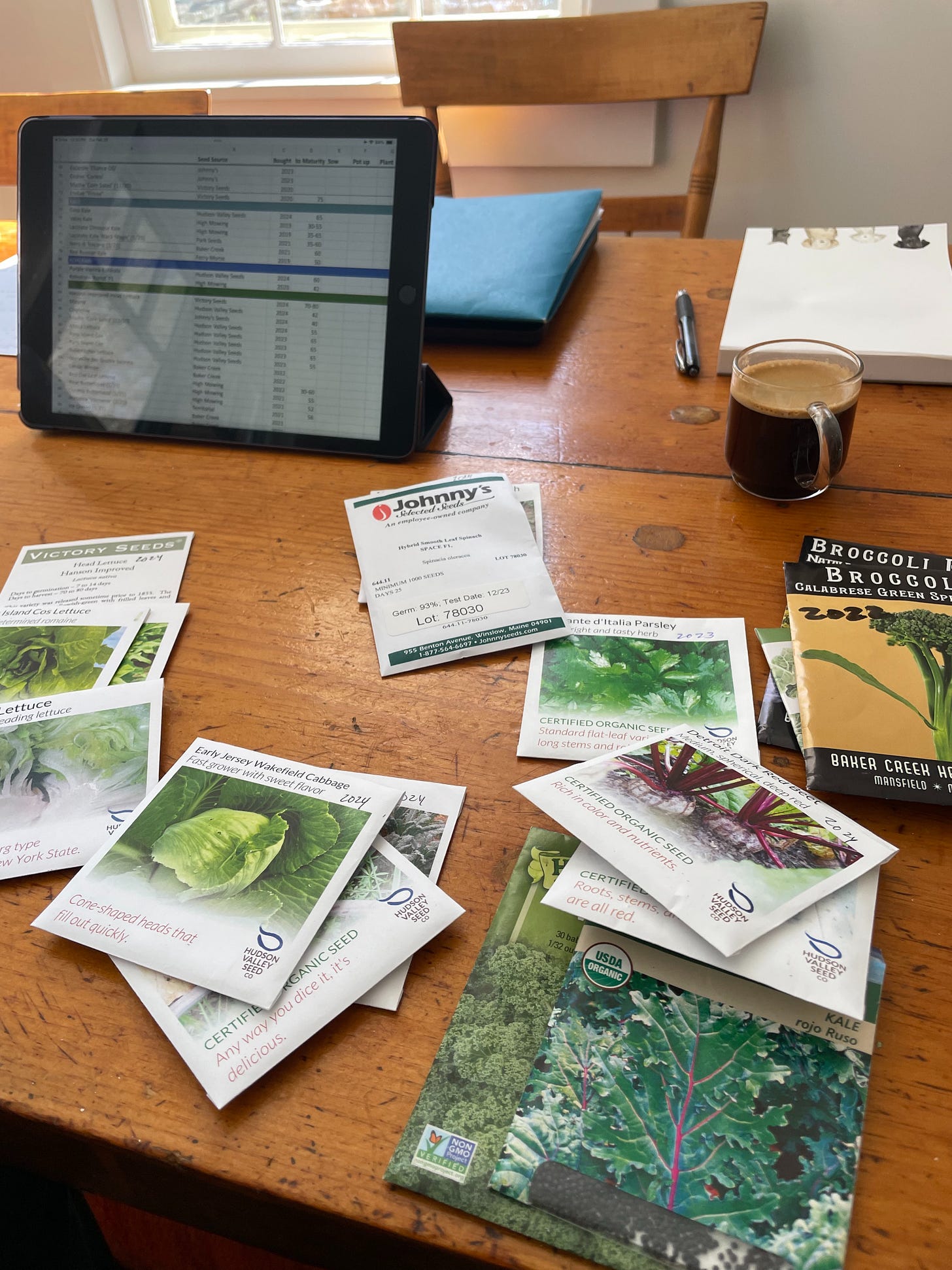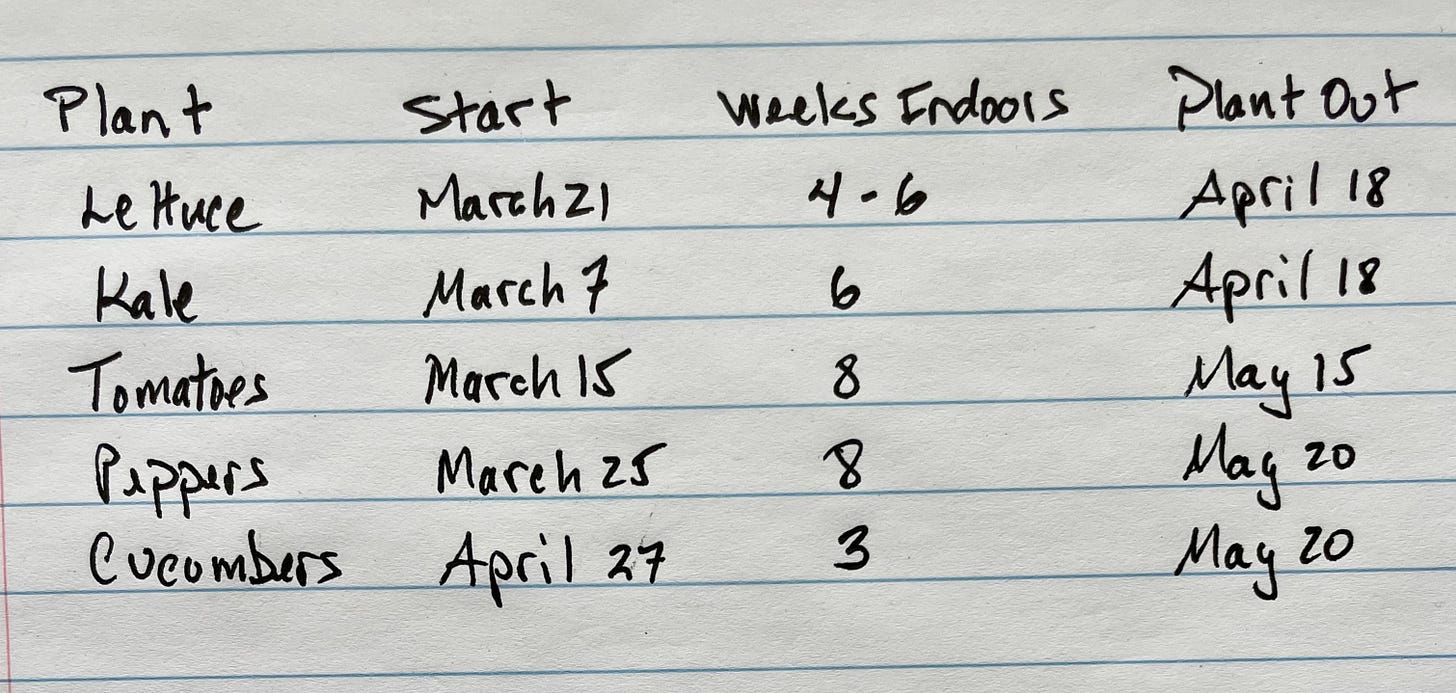Starting your own seeds takes a little planning. Here's how to do it.
It begins with determining your area's last-frost date. After that the most important information you'll need is all on the packets of seeds.
I began starting seeds years ago in a closet in the basement of my home. There were wooden shelves already in the room so I bought three, 4-foot shop lights with standard fluorescent bulbs, suspended them over the shelves with tiny chains and couldn’t wait to get started.
As I recall, I bought peat pellets made by Jiffy in three different sizes. Some were slightly bigger than a quarter, others a bit larger, and there was one pack of pellets measuring 2 or so inches in diameter designed for tomatoes. They came with plastic trays molded to accommodate groups of 12, 24 or 36 pellets.
And off I went.
In my eagerness, I started tomatoes in early January, leading to what would be one of my first lessons in seed starting. Timing is everything, and I was way too early.
The good thing was I successfully germinated a dozen or more tomato plants. The problem was that by mid-March they were 18 inches tall and had overgrown those Jiffy pellets. They were toppling over and their leaves and vines had stretched way above the fluorescent lights. And it was at least six weeks before the weather would be warm enough for me to safely plant them outdoors in the garden.
I nursed those tomatoes along, replanting them into large plastic pots, staking the plants to give them support and moving them to the floor under a fluorescent bulb fixture that I suspended from the ceiling. They luckily survived and I got them into the garden by early May but I could have saved myself a lot of trouble had I taken the time to map out a planting schedule based on the tomatoes’ germination and growth rates and a date for when they can safely be planted outdoors.
I remind myself of that experience each January when all I want to do is to start planting seeds. I admit I take the edge off a bit by growing microgreens, but I’ve learned to channel my energy into planning, which is always a good thing anyway and can actually be kind of fun. It’s the stuff that dreams are made of.
The first thing I do is write down the average last frost date for my area. This is a crucial bit of information around which everything else revolves during the gardening season. Here in the Berkshires in western Massachusetts, it comes in early May, around the 10th, which means there’s a better than even chance temperatures will remain above freezing. In my former home outside Washington, DC, it’s about a month earlier. To find yours, just google the last frost date for your zip code. (Or use an online guide like this one from the Old Farmers Almanac.)
Next, I count back weeks from my last frost date. I do it in increments of four weeks. So with May 10 as the last frost date, April 10 is four weeks before, March 14 is eight weeks before, February 14 is 12 weeks before and so on. These dates are markers for when to start different varieties of seeds. Once you’ve done this, gather your seed packets and take a look. There’s a lot of valuable information on them such as how deep to plant the seeds, how far apart to space the plants in the garden and how tall they will grow. Most also list the number of weeks the seeds should be started indoors before the seedlings can be planted in the garden.
Many seed packets also give you a date for when the seeds can be sown directly into the soil. Some plants like carrots don’t do well when started indoors. Others, like lettuce, arugula or radishes can be planted directly into the garden. My experience is that I have better luck when I start the seeds indoors and plant small seedlings into the garden. It gives the plants a head start and removes a degree of chance.
Getting the timing right is important. As I learned with my tomatoes, starting plants too early means they will grow unwieldy indoors and may affect their production when you get them in the garden. But waiting too long could leave you with immature seedlings not ready for the garden and cost valuable time during the growing season. This is especially true for plants such as leafy greens, broccoli and lettuce that grow best in the cooler weather of spring and early summer.
[Here’s a handy seed-starting date calculator developed by Johnny’s Selected Seeds.]
With your last frost date established you can begin filling out your planting calendar. It doesn’t have to be terribly organized. You can do it on anything from a spreadsheet or desk calendar to the back of an envelope. The important thing is that once you have this information down you’ll know when to start your seeds and, with that, a target for when you should be able safely plant your seedlings in the garden.
When to plant out varies depending on what you’re growing. Leafy vegetables like lettuce and spinach, and most vegetables in the brassica family such as broccoli, cabbage and kale are more cold tolerant and can go into the garden a few weeks before the last frost date – unless, of course, the weather service is predicting an early spring blizzard or deep freeze. In that case you’ll want to hold off. Most of these cool-loving plants are ready for the garden four to six weeks after you sow them. Other plants prefer more warmth, so these don’t get planted outdoors until the last-frost date or even a week or two later. This includes tomatoes, peppers and eggplants as well as many annual flowers like zinnias, nasturtiums and marigolds. These plants take longer to mature, so tomatoes and peppers, for example, are started indoors eight to 10 weeks before the last frost date.
Other heat-loving plants like cucumbers, beans, zucchini and squash germinate more quickly and can be started indoors as late as two to four weeks before last-frost date, or seeded directly in the ground once last-frost date is passed.
Here’s a rough sample schedule for a few different vegetables, based on a May 10 last frost date:
One thing you’ll want to build into your timing is that your seedlings need to be “hardened off” before they go into the ground. What that means is you should slowly introduce them to the outdoors for a week or so by putting them outside in the driveway or garden for a few hours each day, gradually building up the amount of time they’re exposed to the outdoors. Be careful to limit their exposure to direct sun to just an hour on day 1, adding about an hour each day for the week. Placing them in the shade works well also.
Of course, all of this assumes you like the idea of starting your own seeds. There’s absolutely nothing wrong with going to your local garden center or big-box store to buy vegetable and flower seedlings. The most important thing, if you want to grow vegetables or plant a flower bed, is that you do it! You don’t have to go through the effort of starting the seeds on your own. But as someone who’s started their own seeds for many years, here are the advantages, at least as I see them.
The biggest is variety. There’s nothing like going through a seed catalogue and paging through dozens and dozens of tomato varieties and choosing two or three that you want to grow. The same goes for lettuce, peppers, string beans, you name it. There are limitless varieties available, from unique heirlooms to specially designed hybrids that you’ll never see at the garden center.
It also gives you more control on when your planting season begins based on your region, local climate and willingness to experiment and take a little risk. You’re not at the mercy of what’s available at the garden center.
And it’s fun. I’ve said this before but there is something magical about putting a seed into a little bit of soil, giving it water and light and watching it grow, first into a tiny seedling, then a little plant and, within weeks, something beautiful and edible, or both. In a world in which so much seems beyond our control, it’s satisfying to know there are still things that are within it.
A couple notes on my previous post on my favorite seed catalogues.
First, despite my own public warnings, my eyes once again were bigger than my stomach! I managed to order at least a couple dozen packets of seeds this year. I guess if you have to indulge yourself in something – and if you’re trying to navigate your way through a Dry January – there are worse sins than ordering too many flower and vegetable seeds in the mail.
Second, I said I’d be trying out Pinetree Garden Seeds from Waterville, Maine, for the first time. The seeds arrived promptly along with a nice hand-written note of thanks on the invoice. They offered some varieties I hadn’t seen elsewhere. So I’m adding Pinetree to my annual roster.
Next, I’ll share tips on setting yourself up to start your own seeds.
Here’s a selection of other recent posts:
How to grow microgreens, and why they’re good for you






